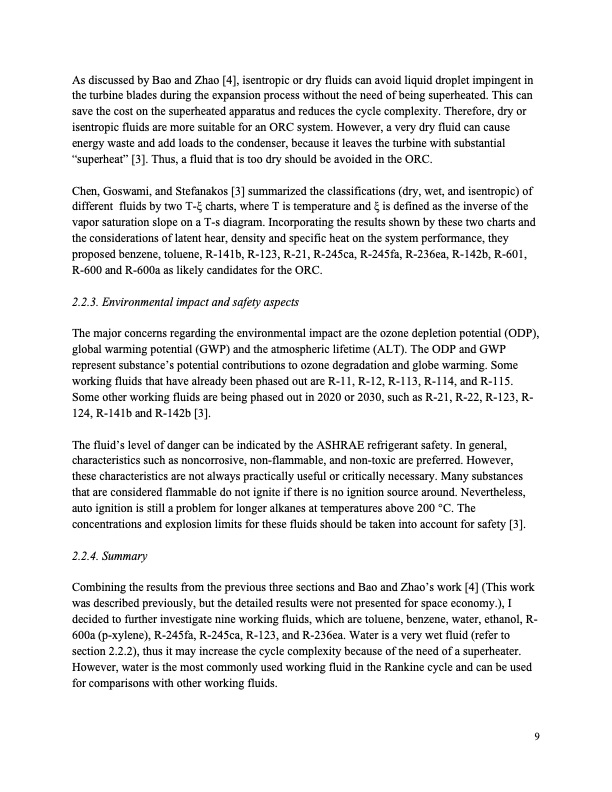
PDF Publication Title:
Text from PDF Page: 009
As discussed by Bao and Zhao [4], isentropic or dry fluids can avoid liquid droplet impingent in the turbine blades during the expansion process without the need of being superheated. This can save the cost on the superheated apparatus and reduces the cycle complexity. Therefore, dry or isentropic fluids are more suitable for an ORC system. However, a very dry fluid can cause energy waste and add loads to the condenser, because it leaves the turbine with substantial “superheat” [3]. Thus, a fluid that is too dry should be avoided in the ORC. Chen, Goswami, and Stefanakos [3] summarized the classifications (dry, wet, and isentropic) of different fluids by two T-ξ charts, where T is temperature and ξ is defined as the inverse of the vapor saturation slope on a T-s diagram. Incorporating the results shown by these two charts and the considerations of latent hear, density and specific heat on the system performance, they proposed benzene, toluene, R-141b, R-123, R-21, R-245ca, R-245fa, R-236ea, R-142b, R-601, R-600 and R-600a as likely candidates for the ORC. 2.2.3. Environmental impact and safety aspects The major concerns regarding the environmental impact are the ozone depletion potential (ODP), global warming potential (GWP) and the atmospheric lifetime (ALT). The ODP and GWP represent substance’s potential contributions to ozone degradation and globe warming. Some working fluids that have already been phased out are R-11, R-12, R-113, R-114, and R-115. Some other working fluids are being phased out in 2020 or 2030, such as R-21, R-22, R-123, R- 124, R-141b and R-142b [3]. The fluid’s level of danger can be indicated by the ASHRAE refrigerant safety. In general, characteristics such as noncorrosive, non-flammable, and non-toxic are preferred. However, these characteristics are not always practically useful or critically necessary. Many substances that are considered flammable do not ignite if there is no ignition source around. Nevertheless, auto ignition is still a problem for longer alkanes at temperatures above 200 °C. The concentrations and explosion limits for these fluids should be taken into account for safety [3]. 2.2.4. Summary Combining the results from the previous three sections and Bao and Zhao’s work [4] (This work was described previously, but the detailed results were not presented for space economy.), I decided to further investigate nine working fluids, which are toluene, benzene, water, ethanol, R- 600a (p-xylene), R-245fa, R-245ca, R-123, and R-236ea. Water is a very wet fluid (refer to section 2.2.2), thus it may increase the cycle complexity because of the need of a superheater. However, water is the most commonly used working fluid in the Rankine cycle and can be used for comparisons with other working fluids. 9PDF Image | Working Fluid Selections in Organic Rankine Cycle ICE

PDF Search Title:
Working Fluid Selections in Organic Rankine Cycle ICEOriginal File Name Searched:
getreport.pdfDIY PDF Search: Google It | Yahoo | Bing
NFT (Non Fungible Token): Buy our tech, design, development or system NFT and become part of our tech NFT network... More Info
IT XR Project Redstone NFT Available for Sale: NFT for high tech turbine design with one part 3D printed counter-rotating energy turbine. Be part of the future with this NFT. Can be bought and sold but only one design NFT exists. Royalties go to the developer (Infinity) to keep enhancing design and applications... More Info
Infinity Turbine IT XR Project Redstone Design: NFT for sale... NFT for high tech turbine design with one part 3D printed counter-rotating energy turbine. Includes all rights to this turbine design, including license for Fluid Handling Block I and II for the turbine assembly and housing. The NFT includes the blueprints (cad/cam), revenue streams, and all future development of the IT XR Project Redstone... More Info
Infinity Turbine ROT Radial Outflow Turbine 24 Design and Worldwide Rights: NFT for sale... NFT for the ROT 24 energy turbine. Be part of the future with this NFT. This design can be bought and sold but only one design NFT exists. You may manufacture the unit, or get the revenues from its sale from Infinity Turbine. Royalties go to the developer (Infinity) to keep enhancing design and applications... More Info
Infinity Supercritical CO2 10 Liter Extractor Design and Worldwide Rights: The Infinity Supercritical 10L CO2 extractor is for botanical oil extraction, which is rich in terpenes and can produce shelf ready full spectrum oil. With over 5 years of development, this industry leader mature extractor machine has been sold since 2015 and is part of many profitable businesses. The process can also be used for electrowinning, e-waste recycling, and lithium battery recycling, gold mining electronic wastes, precious metals. CO2 can also be used in a reverse fuel cell with nafion to make a gas-to-liquids fuel, such as methanol, ethanol and butanol or ethylene. Supercritical CO2 has also been used for treating nafion to make it more effective catalyst. This NFT is for the purchase of worldwide rights which includes the design. More Info
NFT (Non Fungible Token): Buy our tech, design, development or system NFT and become part of our tech NFT network... More Info
Infinity Turbine Products: Special for this month, any plans are $10,000 for complete Cad/Cam blueprints. License is for one build. Try before you buy a production license. May pay by Bitcoin or other Crypto. Products Page... More Info
| CONTACT TEL: 608-238-6001 Email: greg@infinityturbine.com | RSS | AMP |